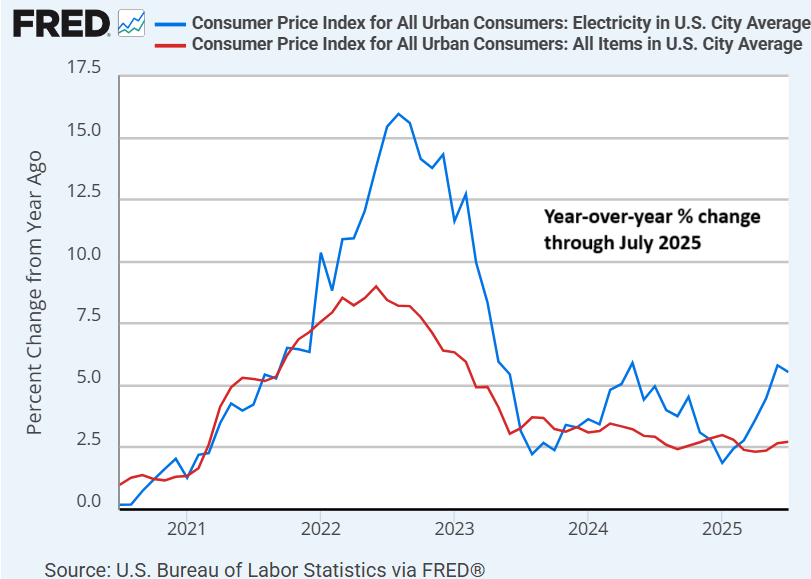Multiple factors are driving up prices for electricity at a time when inflation anxiety is mounting. Next month’s report for August, just days ahead of the on interest rates, will be closely read for deciding if tariffs are starting to drive up pricing pressure.
Electricity inflation could be a growing factor for inflation risk. The year-over-year change for the electricity component of the consumer price index rose 5.5% through July — more than double the pace for CPI overall. Although electricity’s weight in CPI is low, the runup in prices could be a sign of things to come for inflation overall, as it was in 2022.

The Bureau of Labor Statistics reports that the surge in electric prices started in 2022, based on the average price electricity per kilowatt-hour for the US city average.

The growing use of air conditioning, combined with climate change, is another factor. Ditto for the expanding use of electronic devices and electric vehicles.
“It’s a pretty simple story: It’s a story of supply and demand,” observed David Hill, executive vice president of energy at the Bipartisan Policy Center and former general counsel at the US Energy Department, in June.
By some accounts, increased use of fossil fuels will satisfy all or most of the rising demand for electricity. But some analysts question that assumption. Consider, for example, recent estimates by Ember, a think tank that monitors global energy use and supply:
“The US hit a new record low for fossil fuels in the electricity mix last month as solar and wind reached a record high, according to new data from global energy think tank Ember.”
Alternative energy generation can help increase supply, but the Trump administration seems intent on slowing if not reducing reliance of US energy sources on solar, wind and other non-fossil-fuel components.
“There is a lot the administration can do to avoid rate increases. The problem is they aren’t doing it,” advises Rob Gramlich, president of Grid Strategies, a consultancy firm.
President Trump’s attacks on solar and wind projects will exacerbate an approaching power supply shortage and raise prices, predicts Kevin Smith, CEO of Arevon, a solar and battery storage developer.
“I don’t think everybody realizes how big the crunch is going to be,” Smith said. “We’re making that crunch more and more difficult with these policy changes.”
Higher electricity prices will also be inflationary. The weight of electricity in headline CPI is only 2.3%, and so by itself it’s a relatively small influence. But given that electricity is integral to a growing share of economic activity suggests that higher prices will eventually spill over into the wider economy.
How much so? Next month’s CPI report will be closely read for deciding if electricity inflation will be shocking for the near-term macro outlook.
